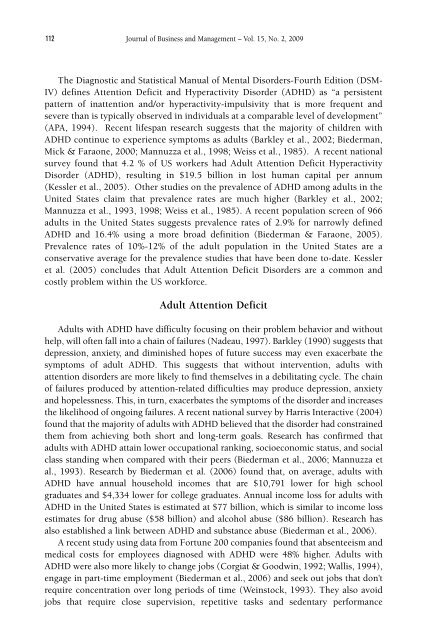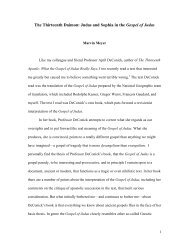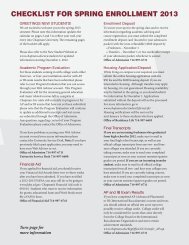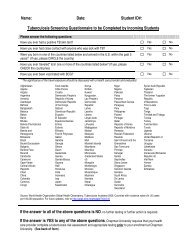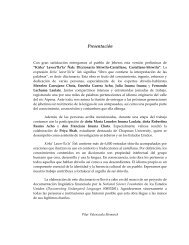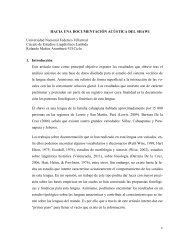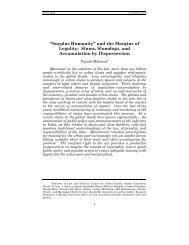112 Journal of Business and Management – <strong>Vol</strong>. <strong>15</strong>, <strong>No</strong>. 2, <strong>2009</strong>The Diagnostic and Statistical Manual of Mental Disorders-Fourth Edition (DSM-IV) defines Attention Deficit and Hyperactivity Disorder (ADHD) as “a persistentpattern of inattention and/or hyperactivity-impulsivity that is more frequent andsevere than is typically observed in individuals at a comparable level of development”(APA, 1994). Recent lifespan research suggests that the majority of children withADHD continue to experience symptoms as adults (Barkley et al., 2002; Biederman,Mick & Faraone, 2000; Mannuzza et al., 1998; Weiss et al., 1985). A recent nationalsurvey found that 4.2 % of US workers had Adult Attention Deficit HyperactivityDisorder (ADHD), resulting in $19.5 billion in lost human capital per annum(Kessler et al., 2005). Other studies on the prevalence of ADHD among adults in theUnited States claim that prevalence rates are much higher (Barkley et al., 2002;Mannuzza et al., 1993, 1998; Weiss et al., 1985). A recent population screen of 966adults in the United States suggests prevalence rates of 2.9% for narrowly definedADHD and 16.4% using a more broad definition (Biederman & Faraone, 2005).Prevalence rates of 10%-12% of the adult population in the United States are aconservative average for the prevalence studies that have been done to-date. Kessleret al. (2005) concludes that Adult Attention Deficit Disorders are a common andcostly problem within the US workforce.Adult Attention DeficitAdults with ADHD have difficulty focusing on their problem behavior and withouthelp, will often fall into a chain of failures (Nadeau, 1997). Barkley (1990) suggests thatdepression, anxiety, and diminished hopes of future success may even exacerbate thesymptoms of adult ADHD. This suggests that without intervention, adults withattention disorders are more likely to find themselves in a debilitating cycle. The chainof failures produced by attention-related difficulties may produce depression, anxietyand hopelessness. This, in turn, exacerbates the symptoms of the disorder and increasesthe likelihood of ongoing failures. A recent national survey by Harris Interactive (2004)found that the majority of adults with ADHD believed that the disorder had constrainedthem from achieving both short and long-term goals. Research has confirmed thatadults with ADHD attain lower occupational ranking, socioeconomic status, and socialclass standing when compared with their peers (Biederman et al., 2006; Mannuzza etal., 1993). Research by Biederman et al. (2006) found that, on average, adults withADHD have annual household incomes that are $10,791 lower for high schoolgraduates and $4,334 lower for college graduates. Annual income loss for adults withADHD in the United States is estimated at $77 billion, which is similar to income lossestimates for drug abuse ($58 billion) and alcohol abuse ($86 billion). Research hasalso established a link between ADHD and substance abuse (Biederman et al., 2006).A recent study using data from Fortune 200 companies found that absenteeism andmedical costs for employees diagnosed with ADHD were 48% higher. Adults withADHD were also more likely to change jobs (Corgiat & Goodwin, 1992; Wallis, 1994),engage in part-time employment (Biederman et al., 2006) and seek out jobs that don’trequire concentration over long periods of time (Weinstock, 1993). They also avoidjobs that require close supervision, repetitive tasks and sedentary performance
Coetzer, Hanson and Trimble113conditions (Mannuzza et al., 1993). The disorder is also associated with higheraccident rates and lower productivity (Reynolds, 1996, 1997). Adults with ADHD areperceived by their employers as requiring more supervision and as less able tocomplete assignments (Barkley, 1990).ADHD may also be associated with positive behaviors like ingenuity, creativity, anddetermination (Mannuzza et al., 1993), which may explain why entrepreneurs appearto have relatively higher levels of the disorder (Miller, 1993). In fast-paced workenvironments, adults with ADHD may perform just as well, if not better, than non-ADHD employees (Stuart, 1992). Hartmann (1993) encourages a more encompassingview of adult workers with ADHD by suggesting that employers consider both thenegative and positive behaviors associated with the condition.Research on adult ADHD suggests that the hyperactivity/impulsivity component ofthe disorder may disappear or not exist (Weiss & Hechtman, 1986, 1993), whereas theinattention component and related cognitive symptoms, referred to as Adult AttentionDeficit (AAD), are more likely to persist or develop (Brown, 1995). Brown (1995)suggests that the hyperactivity/impulsivity component should be excluded but alsosuggests that strict reference to the symptoms of inattention may not capture all of thekey symptoms. Brown (1996) proposes five clusters of symptoms, all of which seemto commonly occur among persons with AADs. The five-symptom clusters include:difficulties with activating to work, concentrating, sustaining effort and energy,managing emotional interference, and accessing memory. This suggests that AAD, asopposed to ADHD, may be a more prevalent problem for adult workers and that someof the key symptoms associated with the disorder may have been ignored in previousresearch. Researchers have also expressed concern about strictly treating AttentionDeficit Disorder as a categorical diagnosis, as opposed to a dimensional construct withvarying levels of severity (Achenbach, 1991; Blacker & Tsuang, 1992). Categoricaldiagnosis promotes simplistic use and interpretation of the construct. This researchdefines adult attention deficit (AAD) as a persistent pattern of inattention and relatedcognitive symptoms that occur with varying levels of severity and create additionalchallenges within the academic, work and social life of adults. Although empiricalresearch on the impact of Attention Deficit Disorder and organizational behavior islimited, research to-date suggests that Attention Deficit Disorder is having a widerange of negative consequences in the workplace.The Expected Relationship between AAD and Self-EfficacyAdults who experience ongoing difficulty with activation, concentration, effort,emotional interference, and accessing memory are more likely to have difficultyachieving a sense of personal mastery over key life tasks. This should constrainpersonal performance, thereby negatively affecting what has been called self-efficacy.Social cognitive theory (Bandura, 1986) suggests that cognitive processing of socialinformation can influence human performance. Beliefs about one’s ability to mobilizesufficient effort, cognitive resources and the behavioral strategies necessary forsuccessful task completion are considered important determinants of performance andsatisfaction (Bandura, 1997). Self-efficacy is generally defined as the perceived
- Page 4 and 5: J.B.M.Journal of Businessand Manage
- Page 6 and 7: Journal of Business and Management
- Page 10 and 11: 114 Journal of Business and Managem
- Page 12 and 13: 116 Journal of Business and Managem
- Page 14 and 15: 118 Journal of Business and Managem
- Page 16 and 17: 120 Journal of Business and Managem
- Page 18 and 19: 122 Journal of Business and Managem
- Page 20 and 21: 124 Journal of Business and Managem
- Page 22 and 23: 126 Journal of Business and Managem
- Page 24 and 25: 128 Journal of Business and Managem
- Page 26 and 27: 130 Journal of Business and Managem
- Page 29 and 30: Larson and Fowler133Research Hypoth
- Page 31 and 32: Larson and Fowler135workplace viole
- Page 33 and 34: Larson and Fowler137preparation and
- Page 35 and 36: Larson and Fowler139The tragedy tha
- Page 37 and 38: Larson and Fowler141an exploratory
- Page 39 and 40: Jacques, Garger, Brown and Deale143
- Page 41 and 42: Jacques, Garger, Brown and Deale145
- Page 43 and 44: Jacques, Garger, Brown and Deale147
- Page 45 and 46: Jacques, Garger, Brown and Deale149
- Page 47 and 48: Jacques, Garger, Brown and Deale151
- Page 49 and 50: Jacques, Garger, Brown and Deale153
- Page 51 and 52: Jacques, Garger, Brown and Deale155
- Page 53 and 54: Jacques, Garger, Brown and Deale157
- Page 55 and 56: Jahiruddin and Haque159Bank Selecti
- Page 57 and 58: Jahiruddin and Haque161Tangibility:
- Page 59 and 60:
Jahiruddin and Haque163As demonstra
- Page 61 and 62:
Jahiruddin and Haque165The second s
- Page 63 and 64:
Jahiruddin and Haque167Table 4: Ran
- Page 65 and 66:
Jahiruddin and Haque169ReferencesAl
- Page 67 and 68:
Ma and Karri171Impact of Firm Perfo
- Page 69 and 70:
Ma and Karri173& Van de Ven, 1983;
- Page 71 and 72:
Ma and Karri175Henderson, 2005). To
- Page 73 and 74:
Ma and Karri177commercial banks in
- Page 75 and 76:
Ma and Karri179dY/dX=b l + 2b 2 X (
- Page 77 and 78:
Ma and Karri181Given this general t
- Page 79 and 80:
Ma and Karri183change. As far as th
- Page 81 and 82:
Ma and Karri185hidden within the la
- Page 83:
J.B.M.Invitation To Review Manuscri
- Page 87 and 88:
ERRATAA typographical error occurre
- Page 89:
ISSN: 1535-668XEditorial Offices: J


